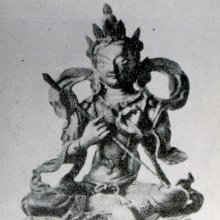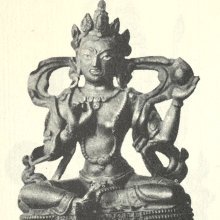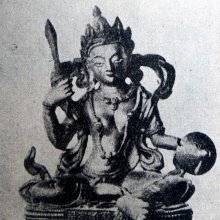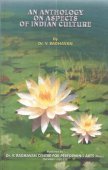Navami, Navamī: 11 definitions
Introduction:
Navami means something in Hinduism, Sanskrit, Jainism, Prakrit, Buddhism, Pali, Marathi, Hindi, Tamil. If you want to know the exact meaning, history, etymology or English translation of this term then check out the descriptions on this page. Add your comment or reference to a book if you want to contribute to this summary article.
Alternative spellings of this word include Navmi.
Images (photo gallery)
In Hinduism
Purana and Itihasa (epic history)
Source: archive.org: Shiva Purana - English Translation1) Navamī (नवमी) refers to the “9th day”, according to the Śivapurāṇa 1.16.
In the month of Karkaṭaka: “A person who seeks prosperity shall worship Pārvatī who bestows all worldly pleasures on Mondays, Navamī (ninth) day, and in the star of Mṛgaśiras in the month of Karkaṭaka.”.
In the month of Āśvayuj: “The Navamī in the bright half of the month of Āśvayuj accords all desired benefits.”.
In the month of Āśvina (September-October): “Satī observed a fast on the eighth day of the bright half (śuklapakṣa) and worshipped Śiva with great devotion. When her Nandā rites were concluded on the ninth day (Navamī), while she was engrossed in meditation, Śiva became visible to her”.
2) According to the Śivapurāṇa 2.3.5, as Brahmā narrated to Nārada the birth of Menā’s daughter:—“[...] Desirous of obtaining a child, she worshipped Śivā everyday for twenty-seven years beginning it in the month of March-April [i.e., caitra-māsa]. Observing a fast on the eighth day of the lunar fortnight, she made charitable gifts of sweets, offerings of oblation rice cakes, puddings and fragrant flowers on the ninth day [i.e., navamī-titha]. [...]”.

The Purana (पुराण, purāṇas) refers to Sanskrit literature preserving ancient India’s vast cultural history, including historical legends, religious ceremonies, various arts and sciences. The eighteen mahapuranas total over 400,000 shlokas (metrical couplets) and date to at least several centuries BCE.
Vaishnavism (Vaishava dharma)
Source: Pure Bhakti: Arcana-dipika - 3rd EditionNavamī (नवमी) refers to one of the various “lunar days” (tithi):—There are approximately 29.5 lunar days in a lunar month. The first fifteen days begin with the first phase of the waxing moon (pratipat) and end with the full moon (pūrṇimā). [...] In accordance with the lunar day, one would utter, [for example, navamī-tithau].

Vaishnava (वैष्णव, vaiṣṇava) or vaishnavism (vaiṣṇavism) represents a tradition of Hinduism worshipping Vishnu as the supreme Lord. Similar to the Shaktism and Shaivism traditions, Vaishnavism also developed as an individual movement, famous for its exposition of the dashavatara (‘ten avatars of Vishnu’).
Ayurveda (science of life)
Veterinary Medicine (The study and treatment of Animals)
Source: archive.org: The Elephant Lore of the HindusNavamī (नवमी) refers to the “ninth stage” (of an elephants’ life), according to the 15th century Mātaṅgalīlā composed by Nīlakaṇṭha in 263 Sanskrit verses, dealing with elephantology in ancient India, focusing on the science of management and treatment of elephants.—[Cf. chapter 5, “on marks of the stages of life”]: “19. With sunken neck, teeth dropping out, all the movements of his body slow, his tusks falling out, eating (only) soft fodder, bereft of must, having no rivals (i.e., incapable of rivalry), dirty (or rough) in color, his body covered with wrinkles, following in the rear of the herd, loose-limbed, who sleeps very much, he is an old elephant in the ninth stage (navamī)”.

Āyurveda (आयुर्वेद, ayurveda) is a branch of Indian science dealing with medicine, herbalism, taxology, anatomy, surgery, alchemy and related topics. Traditional practice of Āyurveda in ancient India dates back to at least the first millenium BC. Literature is commonly written in Sanskrit using various poetic metres.
In Jainism
General definition (in Jainism)
Source: archive.org: TrisastisalakapurusacaritraNavamī (नवमी) refers to one of the 32 mountains between the lotus-lakes situated near the four Añjana mountains, which are situated in the “middle world” (madhyaloka), according to chapter 2.3 [ajitanātha-caritra] of Hemacandra’s 11th century Triṣaṣṭiśalākāpuruṣacaritra: an ancient Sanskrit epic poem narrating the history and legends of sixty-three illustrious persons in Jainism.
Accordingly:—“In the four directions from each of the Añjana Mountains there are lotus-lakes, 100,000 yojanas square: [...]. Between each two lotus-lakes there are 2 Ratikara Mountains so there are 32 Ratikara Mountains (e.g., Navamī). On the Dadhimukha Mountains and on the Ratikara Mountains, there are eternal shrines of the Arhats, just as on the Añjana Mountains likewise at the intermediate points of the continent there are 4 Ratikara Mountains, having a length and width of 10,000 yojanas, and a height of 1,000 yojanas, made of all kinds of jewels, divine, the shape of a jhallarī. [...] In them (i.e., the 32 Ratikara Mountains, e.g., Navamī) the gods with all their splendor together with their retinues make eight-day festivals in the shrines on the holy days of the holy Arhats”.

Jainism is an Indian religion of Dharma whose doctrine revolves around harmlessness (ahimsa) towards every living being. The two major branches (Digambara and Svetambara) of Jainism stimulate self-control (or, shramana, ‘self-reliance’) and spiritual development through a path of peace for the soul to progess to the ultimate goal.
Languages of India and abroad
Pali-English dictionary
Source: BuddhaSasana: Concise Pali-English Dictionarynavamī : (f.) the ninth day of a lunar month.

Pali is the language of the Tipiṭaka, which is the sacred canon of Theravāda Buddhism and contains much of the Buddha’s speech. Closeley related to Sanskrit, both languages are used interchangeably between religions.
Marathi-English dictionary
Source: DDSA: The Molesworth Marathi and English Dictionarynavamī (नवमी).—f (S) The ninth day of the lunar fortnight.
Source: DDSA: The Aryabhusan school dictionary, Marathi-Englishnavamī (नवमी).—f The ninth day of the lunar fort- night.
Marathi is an Indo-European language having over 70 million native speakers people in (predominantly) Maharashtra India. Marathi, like many other Indo-Aryan languages, evolved from early forms of Prakrit, which itself is a subset of Sanskrit, one of the most ancient languages of the world.
Sanskrit dictionary
Source: Cologne Digital Sanskrit Dictionaries: Monier-Williams Sanskrit-English DictionaryNavamī (नवमी):—[from navama > nava] f. (sc. tithi) the 9th day of a lunar half-month.
Sanskrit, also spelled संस्कृतम् (saṃskṛtam), is an ancient language of India commonly seen as the grandmother of the Indo-European language family (even English!). Closely allied with Prakrit and Pali, Sanskrit is more exhaustive in both grammar and terms and has the most extensive collection of literature in the world, greatly surpassing its sister-languages Greek and Latin.
Hindi dictionary
Source: DDSA: A practical Hindi-English dictionaryNavamī (नवमी) [Also spelled navmi]:—(nf) the ninth day of each lunar fortnight.
...
Kannada-English dictionary
Source: Alar: Kannada-English corpusNavami (ನವಮಿ):—
1) [noun] the ninth day of a lunar fortnight.
2) [noun] the cardinal number nine; 9.
Kannada is a Dravidian language (as opposed to the Indo-European language family) mainly spoken in the southwestern region of India.
Tamil dictionary
Source: DDSA: University of Madras: Tamil LexiconNavami (நவமி) noun < navamī. The ninth lunar day after the new or full moon; ஒன்பதாந் திதி. நவமிதனி லிழைத்திடுமேல் [onpathan thithi. navamithani lizhaithidumel] (சேதுபுராணம் துரா. [sethupuranam thura.] 29).
Tamil is an ancient language of India from the Dravidian family spoken by roughly 250 million people mainly in southern India and Sri Lanka.
See also (Relevant definitions)
Starts with: Navamicam, Navamika, Navamivarata, Navamiya.
Query error!
Full-text (+64): Ramanavami, Mahanavami, Durganavami, Aduhkhanavami, Akshayyanavami, Ulkanavami, Talanavami, Shriramanavami, Avidhavanavami, Dhvajanavami, Candikamahanavami, Kushmandanavami, Aduhkha Navami, Ci-ramanavami, Turkkanavami, Caitranavami, Makanavami, Ramanavaminirnaya, Ramanavamipuja, Ramanavamivratakatha.
Relevant text
Search found 61 books and stories containing Navami, Navamī; (plurals include: Navamis, Navamīs). You can also click to the full overview containing English textual excerpts. Below are direct links for the most relevant articles:
Garga Samhita (English) (by Danavir Goswami)
Verses 3.10.31-37 < [Chapter 10 - The Glory of Śrī Girirāja]
Verses 3.10.28-30 < [Chapter 10 - The Glory of Śrī Girirāja]
Padma Purana (by N.A. Deshpande)
Chapter 13 - The Importance of the Vow of Janmāṣṭamī < [Section 4 - Brahma-khaṇḍa (Section on Brahman)]
Isanasivagurudeva Paddhati (study) (by J. P. Prajith)
13. Kamadeva in Isanasivagurudeva-paddhati < [Chapter 3 - Depiction of Gods and Goddesses]
19. Description of Durga (rites and rituals) < [Chapter 4 - Worship of Gods and Goddesses]
The Indian Buddhist Iconography (by Benoytosh Bhattachacharyya)
Puranic encyclopaedia (by Vettam Mani)
Cidgaganacandrika (study) (by S. Mahalakshmi)
Verse 261 [Śakti shines as Prakāśa-Ānanda] < [Chapter 4 - Fourth Vimarśa]
Related products




